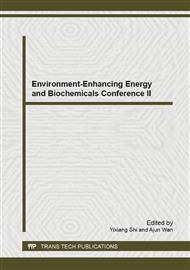[1]
P. Tao, F. He. An analysis of nutrient components in 3 kinds of quickly-growing big seaweeds along Dalian coastal waters. Journal of Fishery Science of China, 7 (2001): 60-63.
Google Scholar
[2]
S. Hirayama, M. Miyasaka, H. Amano. Functional sulfur amino acid production and seawater remediation system by sterile Ulva sp. (Chlorophyta). Applied Biochemistry and Biotechnology, 112(2004): 101-110.
DOI: 10.1385/abab:112:2:101
Google Scholar
[3]
Y. Evgeny. Seaweed Ulva photosynthesis and zero emissions power generation http: /www. pennenergy. com/index/power/renewable-generation.
Google Scholar
[4]
D. M. Hanisak. Cultivation of Gracilaria and other macroalgae in Florida for energy production. In: K. T. Bird and P. H. Benson, 1987 (eds). Seaweed cultivation for renewable resources. Developments in aquaculture and fisheries science, 16. Elsevier, Amsterdam. 1987, p.191.
Google Scholar
[5]
A. Bruhn , J. Dahl , H. B. Nielsen, et al. Bioenergy potential of Ulva lactuca: biomass yield, methane production and combustion. Bioresour Technol. 102(2011): 2595-604.
DOI: 10.1016/j.biortech.2010.10.010
Google Scholar
[6]
M. Benjamin, L. Armando. Enteromorpha is a sustainable aquaculture crop. https: /www. was. org.
Google Scholar
[7]
V. Alberto, V. Gisela, A. Nelson. Evaluation of marine algae as a source of biogas in a two-stage anaerobic reactor system. Biomass and Bioenergy. 32(2008): 338 – 344.
DOI: 10.1016/j.biombioe.2007.10.005
Google Scholar
[8]
H. Y. Lee. Optimization of Pretreatment Process for Bioethanol Production from Ulva Pertusa Kellmann, BIT's 3rd Annual World Congress of Industrial Biotechnology, Dalian (China), July (2010): 25-27.
Google Scholar
[9]
D. H. Kang, H. Y. Lee, J. G. Han, et al. Liquefied extract of marine algae for producing bio-ethanol under high pressure and method for the same. U. S. Patent 7763724. (2010).
Google Scholar
[10]
S. K. Maeve, S. Dworjanyn. The potential of marine biomass for anaerobic biogas yield: a feasibility study with recommendations for further research, Scottish Association for Marine Science Oban, Argyll, Scotland. (2008): 33-36.
Google Scholar
[11]
P. Morand, X. Briand, R. H. Charlier. Anaerobic Digestion of Ulva sp. 3. Liquefaction Juices Extraction by Pressing and a Technico-Economic Budget. Journal of Applied Phycology. 18, (2006) : 741-755.
DOI: 10.1007/s10811-006-9083-1
Google Scholar
[12]
S. B. Velasquez-Orta, T. P. Curtis, B. E. Logan. Energy from algae using microbial fuel cells. Biotechnology and Bioengineering. 103(2009): 1068-1076.
DOI: 10.1002/bit.22346
Google Scholar
[13]
Commission of China Environmental Protection Bureau. Water and Wastewater Analytic Methods. Environmental Science and Technology Press of China, Beijing. 1997, pp.252-259.
Google Scholar
[14]
Z. Yuan, C. Wu, L. Ma, et al. Principle and Technology of Bioenergy Utilization. Chemical and Industrial Press of China, Beijing. 2004, pp.67-79.
Google Scholar
[15]
B. Bian, Y. Zhao. Treatment and utilization of agricultural solid wastes. Chemical Industry Press, Beijing. 2005, pp.174-217.
Google Scholar
[16]
L. Shi, L. Ban, H. Liu, et al. Effect of different temperature on dry anaerobic digestion of animal manure and straw. Journal of Agro-Environment Science, 30 (2011): 782-786.
Google Scholar
[17]
C. Wan, F. Huang, R. Liu, et al. Effect on increasing biogas yield using rape straw by microbiological pretreatment. Transactions of the Chinese Society of Agricultural Engineering, 26(2010): 267-271.
Google Scholar
[18]
Y. Shao, Y. Shi, et al. Experiments on anaerobic digestion of peanut shell for biogas yield under NaOH pretreatment. Journal of Agro-Environment Science, 30(2011): 573-578.
Google Scholar


